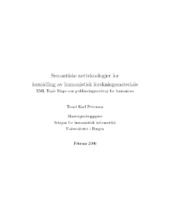Semantiske netteknologier for formidling av humanistisk forskningsmateriale XML Topic Maps som publiseringsverktøy for humaniora
Master thesis
Permanent lenke
https://hdl.handle.net/1956/2038Utgivelsesdato
2006-02Metadata
Vis full innførselSamlinger
Sammendrag
Semantic Web technologies for publication of humanistic research data. XML Topic Maps as a publishing tool for the humanities. Part 1 (chapters 1 through 3) of this master’s thesis consists of a critical discussion of why and how to represent knowledge on the World Wide Web. It starts by giving an overview of the historical development of networks, network technologies and the World Wide Web. Thereafter, insight from the field of Artificial Intelligence is discussed, focusing on the limitations of micro worlds and the separation of algorithm and problem-domain. Knowledge drawn from AI may be seen as converging with that of network technologies and distributed processing, giving us a vision of a Semantic Web where sets of data are self-describing - beyond the context of layout. We define the technologies of such a Semantic Web to be based on four main components: unambiguous identity-criteria, classes, objects, and relations. Hence, Semantic Web technologies and standards must be able to convey information about ontologies, and will typically take the form of associative ‘information overlay’-technologies such as W3C’s Web Ontology Language (OWL) and ISO’s Topic Maps. Part 2 discusses an implementation of a Semantic Web technology. The Web application1 developed as part of this project is used for publication of research data from the project “Det vestnorske hellerprosjektet” at the Department of Archeology, University of Bergen. The project’s findings will be published using XML Topic Maps, which allows us to navigate the information structure based on the semantics of the information model itself.
Utgiver
The University of BergenOpphavsrett
Copyright the author. All rights reservedThe author
